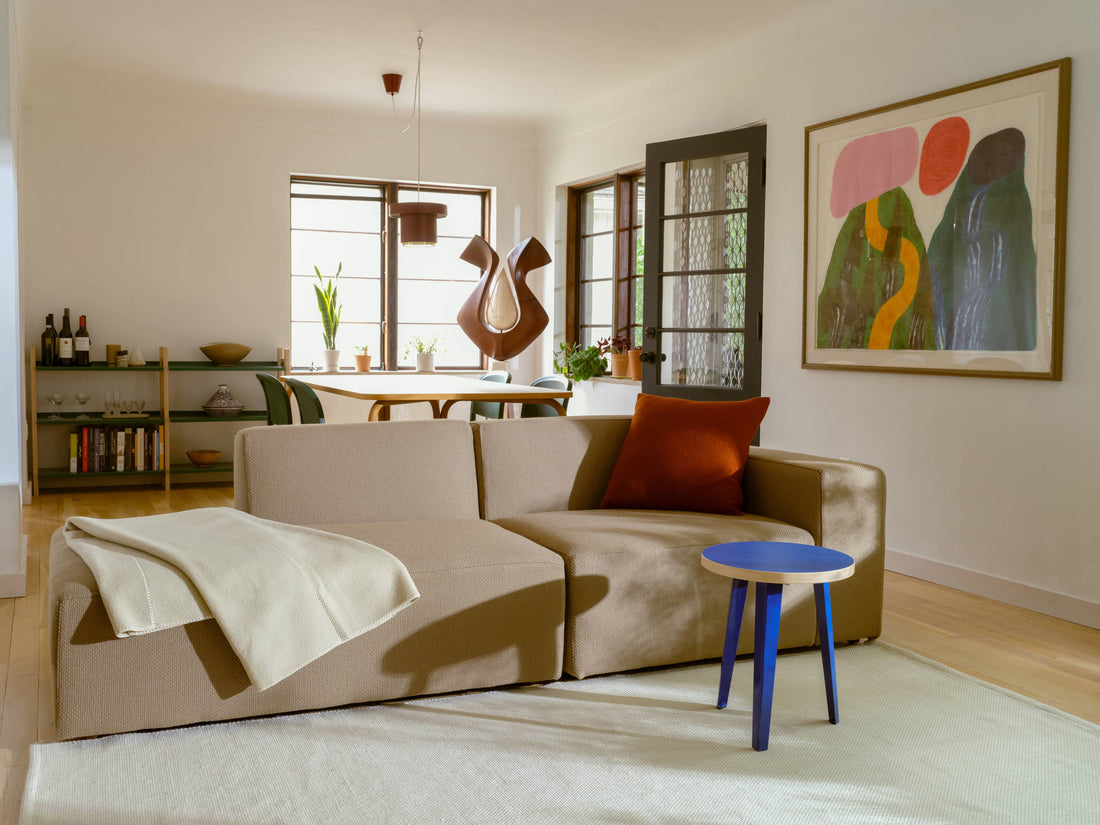How to Design with Versatility in Mind
Designing a home that transcends fads and remains timeless while reflecting your personal style requires careful consideration and a thoughtful approach. By focusing on classic design principles, incorporating elements that have personal significance to you, and opting for enduring materials, you can create a home that will stand the test of time. Here's some tips from our team to help you in the process:
1. The Side Table in Color featured along side The Form Sectional / 2. The Upholstered Headboard in Cobalt. / 3. The Form Sectional in a statement Blue/Red Sisu / 4. Add a pop of color with a standout rug. The Peak Rug in Green/Purple.
1. Embrace Classic Design Principles:
- Classic design principles, such as balance, proportion, and symmetry, have proven timeless over the years. Incorporate these principles into your design to create a harmonious and balanced space.
- Choose items with classic designs and timeless silhouettes. From gently curved lines to clean, straight edges, these shapes contribute to the enduring appeal of classic styles. When choosing furniture, opt for designs with clean lines and well-proportioned forms that can effortlessly blend with various interior aesthetics.
2. Don't Stick with a Single Design Period:
- Blending concepts from different time periods can create a unique and eclectic style in your home, that will make it harder to date it to a single era.
- Look for common design elements that can bridge the gap between different time periods. These elements can include materials, shapes, patterns, or textures. For example, if you have a mid-century modern sofa, you can pair it with a contemporary coffee table with clean lines and a similar wood finish. This connection will help create a visual link between the pieces and make the overall composition more cohesive.
3. Lean Into Statement Pieces:
- A bold-colored sofa, an accent chair, or a brightly painted coffee table can become a focal point and liven up any room. If you prefer neutral furniture, use colorful cushions or throws to add splashes of color.
4. Accessorize with Color:
- Neutral color palettes tend to be timeless and versatile. Choose colors like whites, beiges, grays, and muted tones as the foundation for your home.
- Add pops of color through accessories and furnishings, which can be easily changed over time without a complete overhaul of the space.
5. Play with Pattern:
- Incorporate patterns into your home to add visual interest and excitement. Mix and match patterns in textiles such as rugs, curtains, and throw pillows. Stripes, floral, and geometric patterns can all add a pop of color and interest to your space.
6. Blend Different Materials and Finishes:
- From solid wood to fine upholstery fabrics, attention to material selection is essential. Look for durable, natural materials that age gracefully and contribute to the overall longevity of the furniture.
- Blending furniture materials and finishes can create a harmonious and visually appealing space. By combining different textures, colors, and finishes, you can add depth, contrast, and personality to your home.
7. Curate Meaningful Art and Accessories:
- Display art and accessories that hold personal meaning to you. These pieces will add a unique touch to your home and create a sense of connection.
8. Stay True to Yourself:
- Ultimately, the key to designing a home that reflects your personal style is to stay true to yourself. Don't be swayed by fleeting trends or others' opinions. Trust your instincts and surround yourself with elements that truly resonate with you. Your home should be a reflection of your personality and a place where you feel comfortable and at ease.
Designing a timeless home is about creating a space that you will love for years to come. By incorporating classic design principles, selecting enduring materials, and infusing your personal style, you can achieve a home that transcends fads and stands as a testament to your unique taste.

